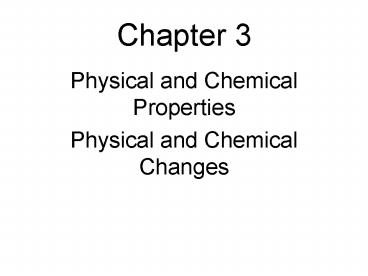Physical and Chemical Properties - PowerPoint PPT Presentation
1 / 26
Title:
Physical and Chemical Properties
Description:
Chapter 3 Physical and Chemical Properties Physical and Chemical Changes Physical Properties Physical properties can be observed or measured without changing the ... – PowerPoint PPT presentation
Number of Views:213
Avg rating:3.0/5.0
Title: Physical and Chemical Properties
1
Chapter 3
- Physical and Chemical Properties
- Physical and Chemical Changes
2
Physical Properties
- Physical properties can be observed or measured
without changing the composition of matter. - Physical properties include appearance, texture,
color, odor, melting point, boiling point,
density, solubility, and many others.
3
What do you think this is?
4
What do you think this is?What physical
properties can be observed?
5
Physical Properties
- Physical State Solid
- Description
- Grayish metal.
- Melting Point 922K 649C 1200F Boiling Point
1363K 1090C 1994F - Density 1.738g/cm3
- Specific Heat 1.02J/gC
6
Chemical Properties
- Chemical properties of matter describe how a
substance reacts to form a new substance(s).
7
Chemical Properties
- Reactivity is really the only chemical
property. Anything that describes how a
substance reacts is a chemical property. - For example hydrogen is explosive.
8
Chemical Properties
- Reacts slowly with water to form a base.
- Reacts violently with acid forming hydrogen gas.
- Reacts with carbon dioxide producing an intense
light.
9
Chemical Properties
Magnesium reacting with dry ice.
10
Magnesium and Carbon Dioxide
11
Physical Changes
- A physical change takes place without any changes
in composition. - The same element or compound is present before
and after the change.
12
Chemical Changes or Reactions
- Chemical changes result in one or more substances
of entirely different composition from the
original substances. - The atoms at the start of the reaction are
rearranged into new substances.
13
(No Transcript)
14
PHYSICAL CHANGE CHEMICAL CHANGE
Do not change the chemical makeup of the changed material (no new substance formed) Result in a new material with a different chemical makeup being formed (new substance formed)
Change only the physical properties of a material Change both physical and chemical properties of a material
relatively simple to reverse very difficult to reverse
Look to be fairly simple changes Look more dramatic
Not Likely to be accompanied by changes in color, temperature, state (unforced), or smell. Often accompanied by change in color, temperature, state ( unforced), or smell.
15
(No Transcript)
16
Sucrose (sugar) reacts with sulfuric acid.
- Sucrose (sugar) reacts with sulfuric acid
creating carbon and water. - C12H22O11 H2SO4 ? different substances
17
Changes of State are physical changes but can
accompany a chemical change.
- Physical Change
- Chemical Change
Precipitate
18
Precipitate
- A solid insoluble substance that forms when
solutions are mixed.
19
Separation Techniques for Mixtures
- Distillation
- Fractional Crystallization
20
Distillation
- Distillation is used to separate parts of a
mixture that have different boiling points. - Distillation is the process of heating a liquid
until it boils, capturing and cooling the
resultant hot vapors, and collecting the
condensed vapors.
21
(No Transcript)
22
Fractional Crystallization
- Separates different solutes from a solution based
on differences in their solubility. - A process by which a chemical compound is
separated by crystallization.
23
(No Transcript)
24
What is the solubility of KNO3 at 80ºC?
160g KNO3 per 100 g water
25
At what temperature is the solubility of KBr
equal to 60g/100g H2O?
10C
26
Homework
- Chapter 3 Worksheet 3-1































